Some plants make me want to grab them by the scruff of their unruly stems, and lecture them about the importance of good manners. Why is that? I have been gardening long enough to be sensitive to plants whose habits in the garden are unsociable.. Making a garden grow is work. How satisfying it is to see what was in a gardener’s mind’s eye come to life. Not that I need to be in charge. Nature bats last, as they say. Disappointments are one thing, but some plants are brats, and I dislike them interfering with the pleasure I take in my garden. There are those plants that flop over at the slightest insult from wind or rain -as in these peonies. Some flop open from the center out- -as in every cat mint I have ever grown. I have seen plenty of bearded iris bloom stalks go out of vertical, or flop face down in the dirt.
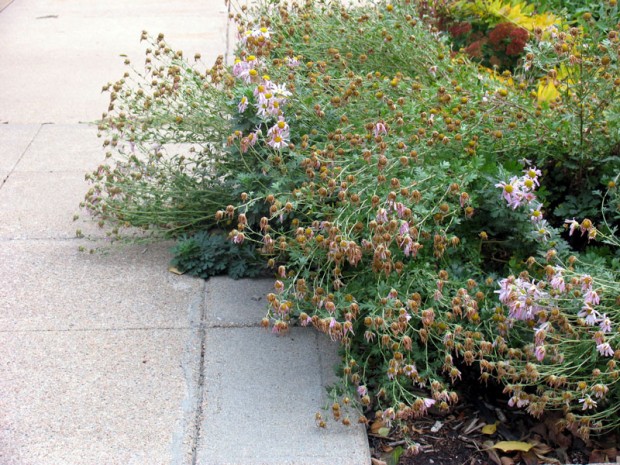 There is an entire industry revolving around the sale of anti flop props for plants. Cages, stakes, wire and what have you. I am a fan of those plants that can handle gravity. I avert my eyes from a garden plant that is slouching, or lying on the ground.
There is an entire industry revolving around the sale of anti flop props for plants. Cages, stakes, wire and what have you. I am a fan of those plants that can handle gravity. I avert my eyes from a garden plant that is slouching, or lying on the ground.
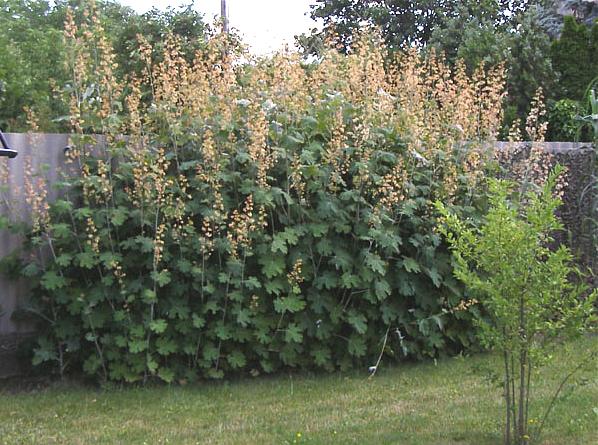 Other plants that do grow to great heights in defiance of gravity, may rudely annex the land belonging to every neighboring plant, and smother them, like this impressive stand of macleaya cordata. Then later in the summer, the lower leaves will yellow and drop and by late summer, the entire plant is unsightly. Surely, some giant stalks will eventually come crashing to the ground. Any other plant you might place in front to cover those legs will eventually be engulfed in more plume poppies.
Other plants that do grow to great heights in defiance of gravity, may rudely annex the land belonging to every neighboring plant, and smother them, like this impressive stand of macleaya cordata. Then later in the summer, the lower leaves will yellow and drop and by late summer, the entire plant is unsightly. Surely, some giant stalks will eventually come crashing to the ground. Any other plant you might place in front to cover those legs will eventually be engulfed in more plume poppies.
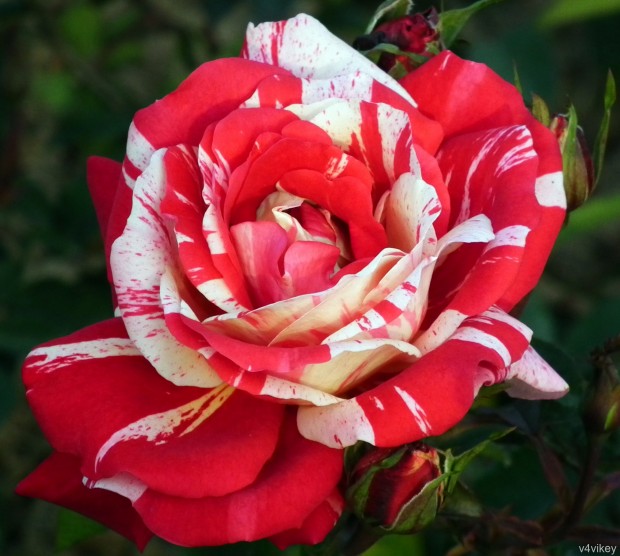 Hybrid tea roses have blooms that are visually seductive, flashy, even astonishing – but the performance of the plant 52 weeks of the year will make your eyes roll back in your gardening head. They attract bugs, fungus and disease from miles around. Not to mention that these grafted beauties regularly fail over my winters. There are other ill mannered prima donna plants demanding this and that, and more of everything else you have. Some of these ill mannered plants threaten to die, and do, should they not get looked after just so. Others just look bad no matter what you do for them – how rude. The astonishing end of their bad manners-plant societies are formed in their name by gardeners who are bound and determined to have them – no matter what that entails. Astonishing, how rational and dirt digging gardeners agree to be bossed around by ill mannered plants.
Hybrid tea roses have blooms that are visually seductive, flashy, even astonishing – but the performance of the plant 52 weeks of the year will make your eyes roll back in your gardening head. They attract bugs, fungus and disease from miles around. Not to mention that these grafted beauties regularly fail over my winters. There are other ill mannered prima donna plants demanding this and that, and more of everything else you have. Some of these ill mannered plants threaten to die, and do, should they not get looked after just so. Others just look bad no matter what you do for them – how rude. The astonishing end of their bad manners-plant societies are formed in their name by gardeners who are bound and determined to have them – no matter what that entails. Astonishing, how rational and dirt digging gardeners agree to be bossed around by ill mannered plants.
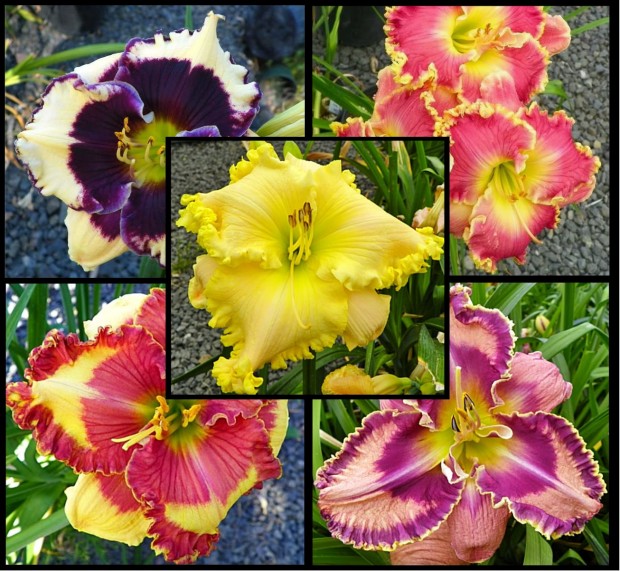 Daylily flowers come in an astonishing array of colors and shapes these days. These cultivars with brilliant color, heavy substance and frilly edges from Roger’s Gardens Daylilies are something else. Wow. Gardeners who do not like the strong color and form such as these may choose cultivars with bloom colors and forms that are a little more subdued. This choice is a matter of taste. The only daylily I have ever planted for clients is Goldner’s Bouquet, bred years ago by Al Goldner. I will plant it, as the bud counts on a mature plant can easy surpass 300, and they do well without much irrigation. Such is their breeding. But all I can really think about when I think daylilies is about the dead and decomposing flower heads that need to be snipped off, every day of the bloom season. Not to mention that once a clump is done blooming, the current year’s foliage immediately starts yellowing and dying back. How boorish is this behavior? If you don’t feel like standing out in the garden regularly on a hot August day, pulling dead stalks and individual yellowing or crispy brown leaves from the plants, you have a mess on your hands that can only be helped by cutting back all of the old foliage, and letting the new foliage come on.
Daylily flowers come in an astonishing array of colors and shapes these days. These cultivars with brilliant color, heavy substance and frilly edges from Roger’s Gardens Daylilies are something else. Wow. Gardeners who do not like the strong color and form such as these may choose cultivars with bloom colors and forms that are a little more subdued. This choice is a matter of taste. The only daylily I have ever planted for clients is Goldner’s Bouquet, bred years ago by Al Goldner. I will plant it, as the bud counts on a mature plant can easy surpass 300, and they do well without much irrigation. Such is their breeding. But all I can really think about when I think daylilies is about the dead and decomposing flower heads that need to be snipped off, every day of the bloom season. Not to mention that once a clump is done blooming, the current year’s foliage immediately starts yellowing and dying back. How boorish is this behavior? If you don’t feel like standing out in the garden regularly on a hot August day, pulling dead stalks and individual yellowing or crispy brown leaves from the plants, you have a mess on your hands that can only be helped by cutting back all of the old foliage, and letting the new foliage come on.
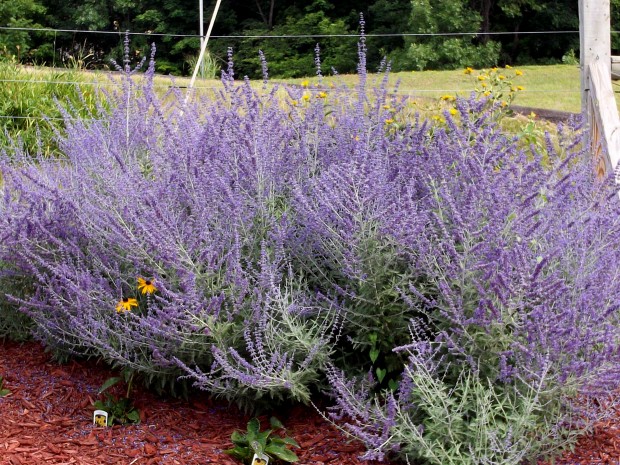 There are some perennial plants that are so unruly you would swear they were weeds. Every year a hybridizer introduces a “smaller growing version” that would permit a gardener with a small garden to have something else besides one Russian sage. Russian sage is a big bully of a perennial whose manners are of the most rudimentary kind. They have an equally uncouth habit in my zone of dying out on one side over the winter. That dead side is invariably facing the kitchen window.
There are some perennial plants that are so unruly you would swear they were weeds. Every year a hybridizer introduces a “smaller growing version” that would permit a gardener with a small garden to have something else besides one Russian sage. Russian sage is a big bully of a perennial whose manners are of the most rudimentary kind. They have an equally uncouth habit in my zone of dying out on one side over the winter. That dead side is invariably facing the kitchen window.
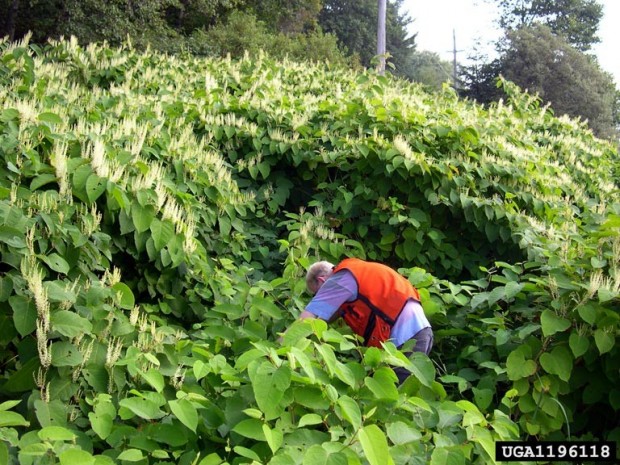 Some vulgar plants spread and infect a garden like the cold virus. Japanese knotweed is not ill mannered, it is nasty.
Some vulgar plants spread and infect a garden like the cold virus. Japanese knotweed is not ill mannered, it is nasty.
 I have been living long enough to spot people who don’t mind their manners. Everyone has had that skunky smell of bad manners close enough to them to wrinkle their nose, and back away. A discussion of unmannerly people is not a topic I want to pursue, besides saying it is easy to spot them. Would that they could spot themselves! This field of garlic mustard looks rather nice in this photograph-but is is ready and willing to go anywhere and everywhere. Garlic mustard is a plant without any manners whatsoever. Beware.
I have been living long enough to spot people who don’t mind their manners. Everyone has had that skunky smell of bad manners close enough to them to wrinkle their nose, and back away. A discussion of unmannerly people is not a topic I want to pursue, besides saying it is easy to spot them. Would that they could spot themselves! This field of garlic mustard looks rather nice in this photograph-but is is ready and willing to go anywhere and everywhere. Garlic mustard is a plant without any manners whatsoever. Beware.
 Unmannerly plants have a hand that they have been dealt. They are who they are. It is very hard to separate phlox and monarda from a discussion of mildew. A double peony originally bred for the cut flower trade does not a garden peony make. My advice? Grow everything you can. Decide which of those plants with less than stellar manners you are willing to make room for. No plant is perfect, although hellebores come close. Pushy plants-beware planting them unless you have a serious containment plan. Invasive plants-avoid them. The spectrum of plants good to grow is big and wide. Grow lots of them, so you can figure out which ruffians you are personally willing to raise.
Unmannerly plants have a hand that they have been dealt. They are who they are. It is very hard to separate phlox and monarda from a discussion of mildew. A double peony originally bred for the cut flower trade does not a garden peony make. My advice? Grow everything you can. Decide which of those plants with less than stellar manners you are willing to make room for. No plant is perfect, although hellebores come close. Pushy plants-beware planting them unless you have a serious containment plan. Invasive plants-avoid them. The spectrum of plants good to grow is big and wide. Grow lots of them, so you can figure out which ruffians you are personally willing to raise.

Very well said !
I loved the whimsical undertone of your description of plants .
I am an avid reader of your blog .
a little sense of humor goes a long way in the garden, doesn’t it?
Many empathetic smiles as I read your post–thanks!
I have these plants in my landscape and I totally agree with you. What plants do you suggest for spring, summer, fall color in the Midwest that won’t have these problems?
Dear Marie, more to come on this topic! best, Deborah
Deborah,
I agree, those plants you mentioned are beautiful, but can also be high-maintnence prima donnas.
Are you considering writing now about garden plants you do love? That may be an endless list!
I am so glad you mentioned those 2 horribly invasive plants, Japanese Knotweed and Garlic Mustard, with which Mitch and I have fought for years to try to eradicate. We have finally been able to keep them confined: in March and April, by pulling up garlic mustard every time we see it and putting it immediately in a bag so the microscopic seeds don’t fall off and germinate. Even 1-2 inch tall plants can flower and drop seeds.
Japanese knotweed is even more difficult, because the roots go down 2 feet or more to a horizontal root that either has to be dug up (right!) or treated by cutting the stalk at ground level and pouring in weed killer. This must be done whenever you see resprouts all season. Still working on this one!
Thanks for all your interesting and informative posts on such a wide range of subjects!
Starr
You speak the truth — love your wisdom — and another tag line might be “Survival of the Fittest”
Dear Carolyn, some really lame performing plants can survive forever. Visits to public gardens can be a way of observing what you might not want to grow!
Without a doubt, gardening is an ongoing live and learn process. I was entertained by your descriptions of daylilies and Russian Sage. I am guilty of having succumbed to their “charms” and I laughingly warn people that they are not literally care free…in fact, they can be rather labor intensive if you want them to look healthy in your garden. I cut back a swath of Russian Sage repeatedly during the growing season and am forever experimenting with manipulating its bloom period.
Dear Deborah,
You have vindicated my position on floppy flowers that faint- especially Daylilies.
As a member of an urban community garden I was nearly
tarred and feathered for even suggesting we jettison the messy clumps. Maybe I am too obsessive, but all that crinkly brown stuff and yellow straws amongst the vibrant annuals kept me up at night. Please don’t get me started on overgrown, unkempt Hostas that desperately need tending to the point where I’ve considered trespassing.
Yes! Out here in California it’s Cape Plumbago, used as a groundcover. Really nice periwinkle flowers in spring-ish, and pretty dark red leaves in late fall, but the UGLIEST scraggy brown leaves and wiry dead stalks and blacked dead flowers for far too much of the year. And hard to get rid of:(.
I have a strict no plant policy on anything that is remotely trying to take over the world. I have done my time in previous gardens with the thugs. This garden inherited some perennial sweet peas, not only do they seed everywhere, but you can not pull them out with their roots, and they have no scent. The only double peony I own is from my Grandmother’s garden. All other peonies must not need to be staked, thank goodness for singles and semi-doubles.
Dear Lisa, I have grown the double peony varieties Moonstone, Kansas, Norma Voltz,and the most fabulous Mrs. FDR-they do not need staking. best, Deborah
Ha ha, very good discussion of ‘ruffian’ plants. Some of these plants you mention are invasive in my area, zone 7a, near Vancouver, Canada. Japanese knotweed is one. Escapes from baskets that some people unknowingly plant out in their backyard like lamium are very vigorous here. I have also lived in a zone 3, where lamium keep itself neat and tidy for the first several years then quietly pushed forward with a spead out and conquer method. With gardening and landscaping, it is always something.
Huge yard, busy job, two kids, I thought bishop’s weed was a lovely way to provide some interest and provide a placeholder in the endless lawn until I had more time to cultivate it with preferred landscaping. MISTAKE. Now that the boys are grown and the job receeded, all I do is pull the stuff and it pops up in the middle of everything, risking uprooting of what I do want to keep.
I have been battling the varigated version for years! I transplanted something from my mother’s, and apparently brought a small piece of root along. Didn’t worry about it 13 years ago, but definitely wish I had, it is all over the place now…. 🙁
Deborah, thank you for this post. I have fought with Russian sage and will not plant it again. And now I have good reasons for not planting daylilies which were not that appealing to me anyway. May I add to your list of ill-mannered plants: English ivy. Here in the Pacific Northwest this plant escapes readily from suburban garden pots and gardens to invade woodland areas, creating “ivy deserts” that prohibit native flora. Our mild winters allow English ivy to grow year round with the only beneficiary being RATS.
Dear Deborah,
Thanks for the lesson on plants with no manners. This year I have been plagued with animals with not manners…namely rabbits. I am dreading what will be lost this year due to there behavior. Any suffused ion in that area would be appreciated. Thanks for all you do.
Best, greg
I would like to add gooseneck loosestrife to the “thug” list. They are truly lovely….like a gaggle of white geese with their crook necks. Many years ago, as a neophyte gardener, I made the mistake of planting three of these plants in exactly the sort of conditions in which they thrive; constantly moist, somewhat heavy soil, good amount of sun. In my zone 5 garden, (Rochester Hills, MI) they did well the first season. I was pleased. Season #2 brought more excellent growth. Season #3….OH NOOOO!!! I spent that season and the following three seasons laboriously digging up the stoloniferous roots before I could eradicate all of it. I know the purple variety of this is no longer sold because it chokes out the native flora and it’s also been a long time since I have seen the white variety in the local nurseries.
Dear Mollie, I did plant this is a garden once-but not without sinking a 24″ deep sheet metal barrier all around it. I do the same thing with butterburr (petasites) and liriope spicata. best, Deborah
Finding plants with good manners which can also survive the weather of the upper Midwest can be challenging.
You mentioned daylilies and how you don’t plant them as their foliage yellows after coming into bloom; I find that true of those hybrids with evergreen parentage, but not of dormant types bred for the northern tier of the United States. There are also some which are self- cleaning as they have sterile or nearly sterile blooms.
Japanese peonies do not flop; the other peonies I prefer to grow but always within cages placed just as the buds begin to form.
I do not like to stake those single-scape flowering plants; gladiolas, delphiniums, larkspur.
I will tie climbing roses and clematis.
Flowering shrubs (hydrangea, viburnums, deciduous azaleas, Korean lilacs, and plants forming nice, clumping mats (creeping phlox, ajugas, bergenia, ginger, allium ‘Summer Beauty’) are favorites of mine.
It seems many flowers which grow in drifts with long blooming periods tend to lay down or have invasive ways. Gardening is work, I guess.
Silverlace vine grew into the aluminum soffits of my deck and bent them into a bulging
rippling mess that allowed wasps to get in and build a gigantic cozy nest in the roof.
It took 5 years of digging roots and hammering copper nails into the deep root stubs to kill it.
This is much worse than ill mannered, P. This plant was assaulting your house. my sympathies, Deborah
I’m chuckling, shaking my head in agreement, and grunting with disgust at the troubles I’ve had with that adorable white gooseneck loosestrife. A gentleman who knows more than I about Michigan gardening warned me, but I was seduced into planting it in one bed, and pay the price each summer digging it out. Russian sage really isn’t enjoying itself at our place so I won’t worry about it taking over, but I ferociously patrol garlic mustard if ever it shows its naughty head, and have been known to wander to a neighbor’s yard with my black bag. No tolerance for garden bullies!
Best advice : If a friend has plenty to share, you don’t want it in your garden!
I love when you write on the specifics of plants. You leave this world a better place when the community of professional gardeners inform the general public about plant habits. The garden centers certainly have no incentive to let us know the difference between long lived from short lived perennials…never the less undesirable habits.
Please keep teaching us. We are hungry for the knowledge.
Ah, you and I are on the same wavelength here. I plant categorise not by the normal terms, mine are, plant divas, triffids, buy one get thousands free and speed spreaders amongst others. And I boring plant labels too, with super colour enhanced images of the flowers that just aren’t realistic!
Deb I just found your site like last week and was reading an older column and you said you grew up on the eastside of Detroit and thought I got to email this wonderful flower lover my name is Deb my husband retired from the DPD Im almost 65 we moved to Arkansas 27 years ago from Grayton Mack and Cadieux and I miss Meldrums real grass packasandra please correct that for me and Im still trying to garden thru F1 tornados ice storms and everything else and cracking rocks…Im sure to die in a yard…love your blog read about you in BGH mag, having an ice event Sunday but maybe Spring by the end of next week already had star magnolias opening and browning already you know how you see the buds in the Fall and get happy with anticipation oh well at my age I know its the wanting that’s the most fun…